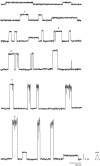Amphotericin B channels in the bacterial membrane: role of sterol and temperature
- PMID: 14507696
- PMCID: PMC1303457
- DOI: 10.1016/S0006-3495(03)74656-6
Amphotericin B channels in the bacterial membrane: role of sterol and temperature
Abstract
Amphotericin B is an antibiotic that forms ion channels in the membrane of a host cell. The change in permeability produced by these channels is greatly improved by sterols; nevertheless, the single channel conductivity remains invariant. Hence, it is proposed that sterols do not act directly, but rather through the modulation of the membrane phase. We look at the formation of these channels in the bacterial membrane to determine the mechanism of its known antibiotic resistance. We found that channels can indeed be formed in this membrane, but a substantial amount of amphotericin B is required. We also study the effects of the antibiotic concentration needed for channel expression as well as the dynamics of channels affected by both sterol and temperature in phosphatidylcholine membranes. The results support the idea that membrane structure is a determining factor in the action of the antibiotic.
Figures





References
-
- Archer, D. B. 1976. Effect of the lipid composition of Mycoplasma mycoides subspecies capri and phosphatidylcholine vesicles upon the action of polyene antibiotics. Biochim. Biophys. Acta. 436:68–76. - PubMed
-
- Cohen, B. E. 1992. A sequential mechanism for the formation of aqueous channels by amphotericin B in liposomes. The effect of sterols and phospholipid composition. Biochim. Biophys. Acta. 1108:49–58. - PubMed
Publication types
MeSH terms
Substances
LinkOut - more resources
Full Text Sources
Other Literature Sources

